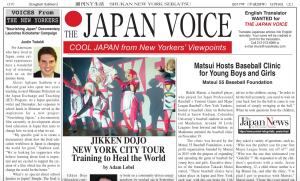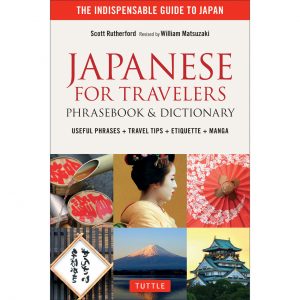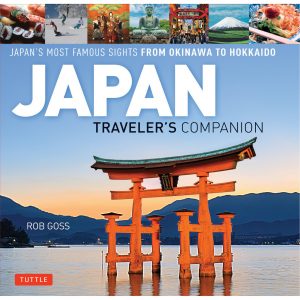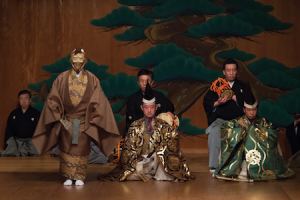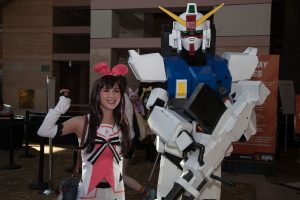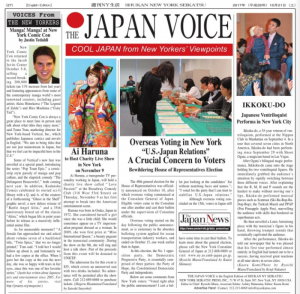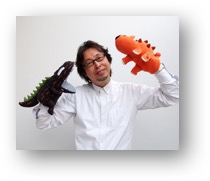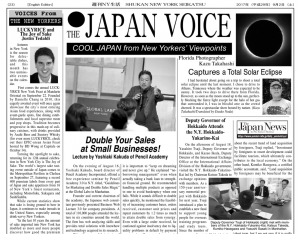JQ Magazine: Book Review — ‘Speak and Read Japanese’
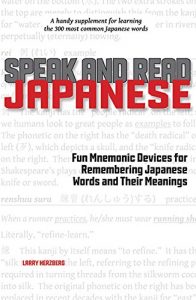
“Speak and Read Japanese won’t be mistaken for the most thorough guide for learning the language. But it is a nice reminder that injecting humor into language learning can go a long way.” (Stone Bridge Press)
By Rashaad Jorden (Yamagata–ken, 2008-10) for JQ magazine. A former head of the JETAA Philadelphia Sub–Chapter, Rashaad is a graduate of Leeds Beckett University with a master’s degree in responsible tourism management. For more on his life abroad and enthusiasm for taiko drumming, visit his blog at www.gettingpounded.wordpress.com.
Your JET experience (hopefully) included a lot of Japanese study. Whether you remember what learned is another story. But it might have helped to concoct some humorous words and phrases to help you best retain the new vocabulary.
Enter the world of mnemonics, courtesy of author Larry Herzberg. The longtime professor has created a language guide titled Speak and Read Japanese: Fun Mnemonic Devices for Remembering Japanese Words and Their Meanings.
You might be wondering, just what are mnemonics? They’re tools language learners might find indispensable in preventing the meanings of new words from escaping their minds. Early in Speak and Read Japanese, Herzberg mentions that such memory hooks have served as the best method of learning new vocabulary in foreign languages for him, for if he could tie the sound of words he was trying to learn to a word in English, he was more likely to retain the new vocabulary.
So is Herzberg’s work a productive tool for language learners? Well, much of the book is an English-Japanese dictionary featuring the translation of many common words and better yet (for hardcore Japanese learners), detailed breakdowns of each word’s kanji as well as literal translations for some terms. You might not have known that hikouki (airplane) is literally translated as “flying-going machine” and shinshitsu (bedroom) means “sleeping room.” And those wanting to improve writing kanji will be pleased to discover a chart of radicals toward the end of the book.
Justin’s Japan: ‘Nourishing Japan’ Documentary Launches Kickstarter Campaign
By JQ magazine editor Justin Tedaldi (CIR Kobe-shi, 2001-02) for Shukan NY Seikatsu. Justin has written about Japanese arts and entertainment for JETAA since 2005. For more of his articles, click here.
For Americans who have lived in Japan, some cultural experiences have a wonderful way of returning with us on the journey home.
Alexis Agliano Sanborn is a Harvard grad who spent two years teaching in rural Shimane Prefecture on the Japan Exchange and Teaching (JET) Program. As a Japan specialist, writer and filmmaker, her exposure to school lunch in Shimane served as the inspiration for a new project: “Nourishing Japan,” a documentary film currently in development about food education in Japan that aims to change how we look at what we eat.
“My specific goal is to create a documentary about how the food education workforce in Japan is changing the world for good,” Sanborn said. “We’re looking for supporters who believe learning about food is important, and are excited to support the creation of a film which has the power to change the world for the better.”
What’s so special about school lunches in Japan? Simple: The food is made from scratch. A 2013 Washington Post article explains: “Schools in Japan give their students the sort of food they’d get at home—not at a stadium, as in the United States….They’re balanced but hearty, heavy on rice and vegetables, fish and soups, and they haven’t changed much in four decades.”
Next year, Sanborn will return to Japan to begin a second round of filming. On January 5th, the “Nourishing Japan” project will launch a Kickstarter crowdfunding campaign to help share the project with the world. With more than 160 likes currently on Facebook, the team is looking to double that number in December. For more information and to view the Kickstarter teaser video, visit http://nourishingjapan.com.
JQ Magazine: Book Review — New from Tuttle (Fall 2017)
By Rashaad Jorden (Yamagata–ken, 2008-10) for JQ magazine. A former head of the JETAA Philadelphia Sub–Chapter, Rashaad is a graduate of Leeds Beckett University with a master’s degree in responsible tourism management. For more on his life abroad and enthusiasm for taiko drumming, visit his blog at www.gettingpounded.wordpress.com.
Tuttle Publishing has released a selection of four books touching on subjects such as otaku culture, language/cultural tips for travelers, Japanese history, and inspiration for prospective visitors to Japan.
Many people have probably developed an interest in Japan through a deep affection for anime and manga (among other things). And with Tokyo being the obvious center of Japanese pop culture, this guide created by Gianni Simone serves as the perfect tool for otaku freaks to find heaven.
Tokyo Geek’s Guide basically resembles a travel guide as it contains tidbits about where to explore otaku culture (such as bookshops, stores, events and even eateries—anime-themed ones are abundant in Tokyo). But you don’t have to be planning a trip to the capital to benefit from the book, though. Simone includes plenty of information pertaining to the history of manga, anime and video games in Japan.
Japanese for Travelers Phrasebook & Dictionary
At first glance, Scott Rutherford’s creation seems like a carbon copy of any other resource geared toward helping travelers avoid or limit communication miscues. And certainly, the book lists the standard customary helpful phrases for visitors to Japan trying to navigate the local hotels, airports, restaurants, etc.
But Japanese for Travelers provides plenty of useful advice about conducting good Japanese etiquette (e.g., what to do when invited to someone’s house) and culture (the section devoted to Japanese naming culture is interesting). Although the guide doesn’t intend to be the most thorough tool for language learners, it does include an English-Japanese glossary and numerous grammatical tips. And perhaps most importantly in this technologically reliant time, Rutherford dedicates a chapter to advising readers about how not to get tripped up by technology in Japan.
To many, the title of Jonathan Clements’s work would seem to be an absolute impossibility. Indeed, he uses that word in the preface to describe his task in telling a story that spans “millions of years.” But Clements settles on “specific moments of transformation” in eleven chapters that address periods of Japanese history ranging from the legend behind Japan’s formation to the “lost decades” that saw the country face a dwindling population and struggling economy.
While the information Clements provides at some points may be overwhelming, A Brief History of Japan does come to life through the collection of images appearing in the middle of the book (such as depictions of prominent figures and photos of landmarks).
Many, if not most, travel guides will feature an endless parade of “what to do and see” recommendations, and Rob Goss’s work is no different in a sense. But unlike some editions of Lonely Planet and Fodor’s, it’s clear when opening up Japan: Traveler’s Companion for the first time that the book will be anything but dry.
The subtitle appearing on its cover is “Japan’s most famous sights from Okinawa to Hokkaido,” but the inclusion of popular tourist destinations isn’t the reason to pick up the book. Amazingly beautiful colorful photos of the country’s most famous places will leave you speechless, and Goss includes helpful information for potential visitors about facets of Japanese life such as matsuri, cutting edge technology, and tradition.
For more information, visit www.tuttlepublishing.com.
For more JQ magazine book reviews, click here.
By JQ magazine editor Justin Tedaldi (CIR Kobe-shi, 2001-02). Justin has written about Japanese arts and entertainment for JETAA since 2005. For more of his articles, click here.
From the silver screen to the stage to J-pop, November is just as colorful as the autumn leaves drifting through the air. Add these live events to the mix and you’ve got an irresistibly epic rundown.
This month’s highlights include:
Now through Dec. 16
Yayoi Kusama: Festival of Life and Infinity Nets
David Zwirner Galleries, 525 and 533 West 19th Street and 34 East 69th Street
Free
Yayoi Kusama’s work has transcended some of the most important art movements of the second half of the twentieth century, including Pop Art and Minimalism. The exhibitions will feature sixty-six paintings from her iconic My Eternal Soul series, new large-scale flower sculptures, a polka-dotted environment, and two Infinity Mirror Rooms in the Chelsea locations, and a selection of new Infinity Nets paintings uptown. The celebrated Infinity Mirror Rooms invite the viewer to experience a sense of infinity through the play of reflections between the circular shapes of light and the surrounding mirrors. The Infinity Net paintings on view at the gallery’s uptown location are the latest works in a series begun in New York in the 1950s, when Abstract Expressionism was still the dominant style. These canvases embodied a radical departure, featuring minutely painted nets across monochrome backgrounds.
Nov. 3-5
Japan Society, 333 East 47th Street
$95, $75 Japan Society members, seniors and students (Nov. 4-5 only)
Part of Japan Society’s NOH-NOW series, celebrating its 110th anniversary! Hiroshi Sugimoto, acclaimed visual artist and traditional Japanese arts connoisseur, offers his most recent noh piece. In this new play, the ghost of revered 16th century tea master Sen-no-Rikyu appears to tell the story of his tragic death by forced suicide. Opening a door onto medieval Japan, the program begins with a tea ceremony by Sen So’oku, direct descendent of Sen-no-Rikyu, and features Japan’s top noh actors and musicians. Performed in Japanese with English titles.

Courtesy of Chopsticksny.com
Nov. 16-Dec. 3
SoHo Playhouse, 15 Vandam Street
$30
Universally funny and yet so very Japanese. Katsura Sunshine makes his highly-anticipated off-Broadway debut! As the world’s first bilingual rakugo-ka (a traditional Japanese comic storyteller), he is an international ambassador of this 400-year tradition. Fresh off 10 smash-hit performances in London’s West End, he will have a series of performances bringing his unique yet authentic rakugo to Off Broadway—in Japanese and English!
Nov. 17-19
Jacob K. Javits Convention Center, 655 West 34th Street
$35-$60; VIP passes also available
“Anime and manga have taken the world by storm. While New York City is the largest city in America, no focused event championing Japanese pop culture calls it home and with a population of eight million there’s a massive demand here,” says Peter Tatara, LeftField Media’s vice president of anime events. “Anime NYC will be a celebration of this community of fans and a platform for publishers and studios from both sides of the Pacific to be in front of the eyes of attendees, trendsetters, and people who aren’t yet familiar with the worlds of anime and manga. We’re looking forward to a vibrant, dedicated celebration of everything in Japan that’s nerdy and cool, in the media capital of the world!”
In this inaugural three-day celebration of Japanese animation powered by Crunchyroll, attendees will be able to view exclusive anime screenings and meet major guests courtesy of international animation and manga publishers; play the latest in Japanese gaming technology; chow down on Japanese delicacies and fusion cuisine; rock out to musical guests direct from Tokyo; and more! An estimated 20,000 fans are expected to attend, with special guests featuring the English-language cast of Sailor Moon Crystal for a panel screening; the U.S. premieres of the films Gundam Thunderbolt: Bandit Flower and Fullmetal Alchemist, and the NY Ramen Summit, featuring a discussion between famed ramen chefs from around the city.
Justin’s Japan: Manga! Manga! at New York Comic Con
By JQ magazine editor Justin Tedaldi (CIR Kobe-shi, 2001-02) for Shukan NY Seikatsu. Justin has written about Japanese arts and entertainment for JETAA since 2005. For more of his articles, click here.
New York Comic Con returned to the Jacob Javits Center October 5-8, selling a record-breaking 200,000 tickets (an 11% increase from last year) and featuring appearances from some of the contemporary manga world’s most renowned creators, including guest artists Akira Himekawa (The Legend of Zelda) and Hiro Mashima (Fairy Tail).
“New York Comic Con is always a great place to meet fans in person and talk about what titles they enjoy most,” said Tomo Tran, marketing director for New York-based Vertical, Inc., which publishes Japanese comics and novels in English. “We aim to bring titles that are not just mainstream in Japan, but that we feel can be impactful here in the U.S.”
Some of Vertical’s new fare was unveiled at a special panel, introducing the series Pop Team Epic, a comic-strip style parody of manga and pop culture, and the slapstick comedy The Delinquent Housewife!, both coming next year. In addition, Kodansha Comics celebrated its storied sci-fi library with a Q&A of the creators of a forthcoming Ghost in the Shell graphic novel, a new deluxe reissue of Battle Angel Alita, and a 35th anniversary boxed set of the classic “Akira,” which began life in print years before its release as a massively influential anime film.
As for memorable moments? “A female fan approached me and asked about volume seven of a backlisted title, Twin Spica, that we no longer printed,” Tran said. “I told her I would follow up about it, and fortunately we had a few copies at the office. When I gave her the copy at the con the next day, she was so happy with tears in her eyes, since this was one of her favorite series.”
Justin has written about Japanese arts and entertainment since 2005. For more of his stories, visit http://jetaany.org/magazine.
JQ Magazine: New York Comic Con, ‘Porco Rosso,’ ‘The Legend of Zelda,’ Food Porn Party
By JQ magazine editor Justin Tedaldi (CIR Kobe–shi, 2001-02). Justin has written about Japanese arts and entertainment for JETAA since 2005. For more of his articles, click here.
The Japan-centric events of the month ahead promise to be as rich and full as autumn itself—brisk and colorful, with a dash of unpredictability.
This month’s highlights include:

Volume 1—FAIRY TAIL © Hiro MASHIMA / Kodansha Ltd.; Hiro Mashima—Photo courtesy of Kodansha Ltd.; Volume 61—FAIRY TAIL © Hiro MASHIMA / Kodansha Ltd.
Thursday, Oct. 5, 6:30 p.m.
Hiro Mashima: The Magical World of Fairy Tail
Japan Society, 333 East 47th Street
$30, $25 Japan Society members, seniors and students
Award-winning manga artist Hiro Mashima, known for his bestselling series Fairy Tail, comes to Japan Society for a special talk in conjunction with New York Comic Con. The epic fantasy series, which has sold over 60 million copies worldwide, follows the rambunctious wizard’s guild Fairy Tail through adventures in a stunning variety of settings, with a mind-boggling array of colorful characters. Mashima, also renowned for his long-running series Rave Master, joins us to discuss the works that have captured the imaginations of fans around the world. Moderated by Ben Applegate, director of the Kodansha Comics publishing team at Penguin Random House, and interpreted by Misaki Kido, marketing director at Kodansha Advanced Media. One lucky guest will win a surprise gift from Mashima-sensei at the event! Followed by a reception.
Oct. 5-8
Jacob K. Javits Convention Center, 655 West 34th Street
Limited tickets available
With a record attendance of more than 170,000 visitors last year, the East Coast’s biggest gathering for fans of comics, film, anime and manga, New York Comic Con returns with its biggest roster of Hollywood talent to date, and features exclusive screenings, gaming, cosplay photo ops, interactive booths by manga publishers including Vertical Comics and Kodansha Comics , and special guest appearances by manga artists Hiro Mashima (Fairy Tail) and Akira Himekawa (The Legend of Zelda)!
Friday, Oct. 6, 7:00 p.m.
Japan Society, 333 East 47th Street
$13, $10 seniors and students, $5 Japan Society members
Screening in 35mm! An ace fighter pilot and ex-member of the Italian Air Force during WWI is mysteriously cursed with a pig’s face. Disillusioned with humanity, he adopts the name Porco Rosso (“Crimson Pig”) and spends his time near the Adriatic Sea, drinking at a local bar and fighting off air pirates for cash. Famous for his unsurpassable flying skills, Porco draws the envy and antagonism of an American pilot who plots to take him down with the help of the fascist Italian police. This sixth film by Hayao Miyazaki is among the master animator’s most personal and underrated, highlighting his deep love for aviation and pacifist worldview within an action-adventure story perfect for adults and children alike.
Premieres Friday, Oct. 13
Metrograph, 7 Ludlow Street
$15
In her new documentary, Lana Wilson (After Tiller) takes us deep inside the life of another extreme altruist, Ittetsu Nemoto, a punk-rocker-turned-Buddhist priest who has worked small miracles in suicide prevention in his native Japan. Now facing the new challenge of fatherhood, as well as rapidly escalating health problems of his own, Nemoto must answer a crucial question—can he justify risking his own life to help others carry on with theirs? With astonishing access and artistry, The Departure captures one man’s wrenching decision between self-preservation and selflessness. Select screenings on Oct. 13 and 14 feature a special Q&A with the director.
Oct. 13-14, 7:30 p.m.
Japan Society, 333 East 47th Street
$35, $30 Japan Society members
Aesthetics of the past, present, East and West meld together in Italian director/choreographer Luca Veggetti’s Left–Right–Left, which explores the point of intersection between Japan’s 14th-century noh tradition and today’s efforts in dance. With leading Japanese butoh and contemporary dancers, esteemed noh musicians and a child noh actor reciting text from noh plays Okina and Hagoromo, this production offers a lens into the microcosm of humanity. Performed in English. The Oct. 13 performance is followed by a MetLife Meet–the–Artists Reception. The Oct. 14 performance is followed by an artist Q&A.
Oct. 13-14, 8:00 p.m.
92nd Street Y (Buttenwieser Hall), 1395 Lexington Avenue
$15-$29
Tap dancer Kazu Kumagai, known for his “powerful athletic technique combined with a riveting clarity” (2016 Bessie Outstanding Performer Award) channels his exceptional rhythmic artistry into the intensity of HEAR/HERE. The program includes a live jazz quartet and guest tappers, including legends Ted Louis Levy and Brenda Bufalino (2016 Bessie Award for Lifetime Achievement). This Dig Dance show is Kazu’s return to 92Y after a sell-out performance last season.
Wednesday, Oct. 18, 7:00 p.m.
The Nippon Club, 145 West 57th Street
$250, $200 members
A one-of-a-kind cultural experience! See Japanese Ozashiki culture in person with Geisha (Geiko and Maiko) from Nara, Japan. They will entertain visitors with their arts such as music, dance, conversations and traditional games while you enjoy Japanese food and sake. For RSVP and more info, call (212) 581-2223, or email info@nipponclub.org, attn: Mita, Uchikawa.
Friday, Oct. 20, 8:00 p.m.
The Legend of Zelda: Symphony of the Goddesses
United Palace Theater, 4140 Broadway
$28.13-$120
Back by popular demand and presented by Jason Michael Paul Productions, The Legend of Zelda: Symphony of the Goddesses returns to New York with breathtakingly new visuals and music exploring additional chapters from the Zelda franchise as well as the beautifully orchestrated two-act symphony recounting the classic storylines from some of the most popular video games in history. Take up your wooden sword and shield as a live orchestra and the Montclair State University Vocal Accord brings to life the masterpieces of legendary Nintendo composer and sound director Koji Kondo.
Oct. 20-Nov. 17 (first rotation); Nov. 21-Jan. 7 (second rotation)
Hiroshi Sugimoto: Gates of Paradise
Japan Society, 333 East 47th Street
Single visit: $12/$10 students and seniors; both rotations: $20/$16 students and seniors;
free for Japan Society members; free admission on Fridays from 6:00 p.m.-9:00 p.m.
This fall, explore one of the earliest, and largely unknown, encounters between Japan and the West in the 16th century, as seen through the eyes of artist Hiroshi Sugimoto. In celebration of Japan Society’s 110th anniversary, Hiroshi Sugimoto: Gates of Paradise charts the story of four Japanese boys, who were swept up in the tide of religion, commerce and politics during the first Global Age and sent to the princely and papal courts of Europe. Journey in their footsteps through Sugimoto’s new monumental photographs of the sites they visited, and navigate the germination of cultural exchange between East and West with classical masterpieces of visually hybrid (nanban) art from Japanese and American collections. Join guests for the Escape East @333 happy hours on Oct. 20 and Nov. 10 at 6:00 p.m.

Courtesy of USA.kinokuniya.com
Saturday, Oct. 21, 2:00 p.m.
Tatsuya Miyanishi: Tyrannosaurus series
1073 Sixth Avenue
Acclaimed Japanese children’s author and illustrator Tatsuya Miyanishi will visit the U.S. for the first time this month! His Tyrannosaurus series consists of 12 titles and has sold more than 3 million copies in Japan, China, Korea, Taiwan, and France. There are four titles available in English so far from Museyon. Bring your kids to a nearby Kinokuniya Book Store (other cities including Edgewater, NJ are listed in the photo here) between October 21st and 29th for a presentation and book signing! Miyanishi is an entertaining presenter who will draw, read from his books, and discuss his work. A book signing will follow each presentation.
Saturday, Oct. 21, 7:00 p.m.
The Food Porn Party featuring Tampopo
AMC Empire 25, 234 West 42nd Street
$95, $125 VIP (use code “RESOBOX” for 10% off tickets)
Taste what you see on the screen! The Food Film Festival specializes in creating multisensory food and film experiences. At their events, guests watch films about food and simultaneously taste the exact dishes they see on the screen…right in their seats! Hosting their “Food Porn” Party featuring the cult classic film, Tampopo. Following the film, they are inviting everyone to join their Japanese Noodle Fest! Directed by Jûzô Itami, the tale of an enigmatic band of ramen ronin who guide the widow of a noodle shop owner on her quest for the perfect recipe, Tampopo serves up a savory broth of culinary adventure seasoned with offbeat comedy sketches and the erotic exploits of a gastronome gangster. Sweet, sexy, surreal, and mouthwatering, Tampopo remains one of the most delectable examples of food on film. Following the movie, there will be a Japanese noodle feast featuring ramen and more ramen, decadent dishes, cocktails, craft beer and more! Additional Food Film Festival events include James Beard: America’s First Foodie (Oct. 19), Hometown Heros: The Legend of the Chopped Cheese (Oct. 20), and For the Love of Brunch (Oct. 22). For a complete listing, click here.
Friday, Oct. 27, 11:30 a.m.-9:30 p.m.
NYC Event Spaces, 4 West 43rd Street
$35-$75
Chopsticks NY magazine presents its very first Sake and Food event, “Eat Up! Drink Up! Japan” on Oct. 27. During the event, we will divide Japan into six regional blocks and offer craft sake from each block and matching food made with the regional delicacies. Participants can appreciate sake from nationwide Japan and feel the sense of “terroir” in Japan. 18 dishes from nationwide, 3 from each block, will be served during the event. Every dish is crafted to be paired with regional sake. There will be at least one vegetarian dish in each block. Over 30 brands of sake, at least five brands for each region, will be served along with the dishes above. This event is 21 and over.
Saturday, Oct. 28, 6:30 p.m.
Ages of Enchantment: JPA Cultural Repertoires 2017
Symphony Space (Peter Jay Sharp Theater), 2537 Broadway
$30; $25 members; $18 seniors, students and children; $40 day of show
JPA returns for its first show in two years! This year’s performance consists of three categories: 1) Kimono show, 2) traditional Japanese dances, and 3) Japanese folk performing arts (from three regions). During the kimono show, five major kimono types will be shown with different craftsmanship with live models. The details of handcrafted fabric weaving, coloring, and decorating techniques will be explained, so when the audiences actually see the real kimono display, it can promote better learning experiences. After the kimono show, five pieces of traditional Japanese dance will be shown as the second section. The first piece is titled as the “Duet,” which is a rare parallel performance of Japanese traditional dance and Western ballet. The piece will display the differences between the two dance movements and the body uses by the dancers, so the audiences will be able to see the unique characteristics of Japanese dance much easier. The body use will be explained in the context of the cultural characteristics as well.
Oct. 29-Nov. 1
Various locations
$12.50-$13.50
Hayao Miyazaki’s Academy Award-winning masterpiece Spirited Away was the biggest box office hit of all time in Japan and helped redefine the possibilities of animation for American audiences and a generation of new filmmakers. Chihiro thinks she is on another boring trip with her parents. But when they stop at a village that is not all that it seems, her parents undergo a mysterious transformation, and Chihiro is whisked into a world of fantastic spirits, shape-shifting dragons and a witch who never wants to see her leave. She must call on the courage she never knew she had to free herself and return her family to the outside world.
Combining Japanese mythology with Alice in Wonderland-type whimsy, Spirited Away cemented Miyazaki’s reputation as an icon of animation and storytelling. The English-dubbed cast includes the vocal talents of Daveigh Chase, Jason Marsden, Suzanne Pleshette, David Ogden Stiers, Susan Egan, Tara Strong and more! Dubbed in English on Oct. 29 and November 1 and subtitled on Oct. 30, this special three–day event will also feature GKIDS Mini–Fest, an ongoing festival of the best animated shorts from around the world.
Want to stay in the loop on future events? Follow Justin on Facebook and Twitter.
JQ Magazine: Film Review — ‘The Red Turtle’

A critical analysis couched in fiction of the Academy Award-nominated Studio Ghibli co-production (Sony Pictures Classics)
By Preston Hatfield (Yamanashi-ken, 2009-10) for JQ magazine. Preston is the English teacher you wish you had growing up. He taught in Kofu, Yamanashi on JET and later received his Master’s in Education and teaching credential from Stanford University. He now teaches English at a public high school in the Silicon Valley, and is inspiring the leaders of tomorrow one dank meme at a time.
TL;DR: Directed by Dutch animator Michaël Dudok de Wit, The Red Turtle is another visual masterpiece by Studio Ghibli (making its external co–production debut here collaborating with a European team) with a unique artistic style that makes the scenery itself a prominent character. Though it lost me in parts, the story is poignant and evokes an array of feelings, few of which are pleasant, though nonetheless life–affirming. In order to fully appreciate this film (which has no dialogue), you need to be in a calm, patient, and cerebral mood. Also, make sure you watch it in a very dark room, as the film features numerous nighttime scenes that are hard to see with extra light.
You never asked from whence I came, if I had a family in my own land, if I was happy in my new life. I suppose you found those details immaterial as far as we were concerned, but you should know that from the moment I opened my eyes and coughed the seawater from my lungs on that accursed beach we called home, after surveying the island high and low, near and far, and discovering no human civilization from which I could find salvation, I devoted every precious calorie in my body to escaping that forsaken rock, ocean be damned.
Let my words carry across time and space; to echo across the sky and go bounding beyond the reach of the island that tethered me. Let me communicate what I couldn’t before. Let my memory endure, because I have lost everything else. Let me go.
I’ll never forget the first time I saw you, a scarlet leviathan that decimated my rafts like waves over sandcastles. I admit I never quite worked it out. Was it your will or the island’s that kept me from leaving? Who did I enrage so with my escape plan and headstrong persistence in the face of constant setback? I guess what I’m asking is, were you the warden of the prison, or just one of the guards? There in the open ocean I gazed at you, awe-struck, sure in that moment that you were going to kill me for being so daring.
JQ Magazine: Film Review — ‘Hayao Miyazaki: Never-Ending Man’
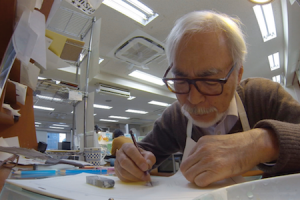
“This tight, 70-minute documentary does not wander. It preserves a feeling of deliberate pacing and purpose through clever editing, and possibly even some deliberate misdirection, which echo Miyazaki’s personal deliberations.” (© NHK)
By Greg Beck (Hiroshima–ken, 2006-11) for JQ magazine. Greg is a writer, producer, home brewer, and Social Coordinator for JETAA Southern California and Arizona. A former news producer for Tokyo Broadcasting System in New York, he currently works freelance in Los Angeles. For more cinema reviews, follow him on Twitter at @CIRBECK #MovieReview.
Receiving its East Coast premiere last night at Japan Society in New York, NHK’s new documentary on Studio Ghibli’s famed animation director Hayao Miyazaki offers a seemingly deep and undeniably personal look into the man’s current life, as well as his achievements and challenges, both artistically and—in his old age—existentially. True to Japanese-style filmmaking, we see a series of scenes as they happen, and are left to draw our own meaning. Still, this tight, 70-minute documentary does not wander. It preserves a feeling of deliberate pacing and purpose through clever editing, and possibly even some deliberate misdirection, which echo Miyazaki’s personal deliberations.
The film starts with Miyazaki’s retirement announcement at a press conference in September 2013. It then jumps forward two years, to an unseen and seldom-heard cameraman, whose perspective we take for this fly-on-the-wall documentary. Entering his gorgeous, countryside atelier, Miyazaki grumbles humbly, “What do you have a camera for? There’s nothing worth seeing. I’m retired.” He feeds birds, smokes, makes tea, and gripes about the complacency of Disney’s Frozen anthem “Let It Go,” but in no time shows that his creative drive is undiminished. Walking to a table covered in a pile of pages of new projects and material, he insists, “I’m a retired pensioner. I’m just fooling around now.” Read More
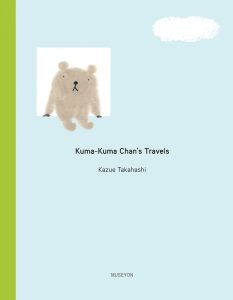
“Takahashi’s warm watercolors and relatable stories are guaranteed to entertain readers of all ages, and the latest English-language addition to this series, Kuma-Kuma Chan’s Travels, is every bit as enjoyable as its two predecessors.” (Museyon)
By Stacy Smith (Kumamoto-ken CIR, 2000-03) for JQ magazine. Stacy is a New York City–based provider of top quality Japanese interpreting, translating and writing/editing services. Starting from her initial encounter with Japan in her teens, she has built up a consummate understanding of the country‘s language and culture, enabling her to seamlessly traverse between Japan and the U.S. and serve as a bridge between the two. For more information, visit www.stacysmith.webs.com. As a writer, Stacy also shares tidbits and trends with her own observations in the periodic series WIT Life.
Having spent three years on JET in Kumamoto, home of nationwide sensation Kumamon who didn’t yet exist when I was there, I must honestly say that I approach bear characters with slight trepidation. However, I was delightfully surprised to love every minute of my encounter with Kuma-Kuma Chan, the bear who stars in the eponymous children’s book series written and illustrated by Kazue Takahashi. Her warm watercolors and relatable stories are guaranteed to entertain readers of all ages, and the latest English-language addition to this series, Kuma-Kuma Chan’s Travels, is every bit as enjoyable as its two predecessors.
The previous two books, Kuma-Kuma Chan, the Little Bear (previously reviewed in JQ here) and Kuma-Kuma Chan’s Home, looked at a day in the life of Kuma-Kuma Chan on his own and when a friend comes to visit. Kuma–Kuma Chan’s Travels is a bit more expansive, introducing readers to his world when he takes trips. I love the details at the beginning sharing what he brings with him on his journeys, along with accompanying illustrations such as a Thermos containing hot coffee. We later see him on top of a mountain drinking said coffee while watching the sunrise. These trips take place inside his head, but the descriptive text and beautiful pictures make you feel like you are with him everywhere he goes.
The series as a whole features a strong element of kawaii, or cuteness, which contributes to its Japaneseness. Also, there is an intangible sensibility to the stories that make them feel a bit different than traditional Western children’s books. In the inaugural Kuma–Kuma Chan, the Little Bear, we learn about his daily routine, which includes aspects such as eating a big salad for breakfast with lettuce from his garden and personal grooming like trimming his nails and hair. I particularly liked the scene which shows him during the winter, rolling around to catch the sunlight as the day progresses with the kerosene heater nearby. For many JET alumni, I’m sure this scene will be reminiscent of days spent in school offices where this was the sole source of heat.
For readers seeking a creature of a different nature, the Tyrannosaurus children’s books written and illustrated by Tatsuya Miyanishi is another series worth checking out. It currently features 13 titles, four of which have been published in the U.S. For those who would like to learn about these books and meet the acclaimed author, he will be at the New York and New Jersey locations of Books Kinokuniya at 2 p.m. on October 21 and 22, respectively. On both days, Miyanishi will be reading from and discussing his works, as well as signing books for those with purchased copies. For more dates in Texas, Washington and California, click here.
Kuma-Kuma Chan’s Travels is available October 1. For more information, click here.
For more JQ magazine book reviews, click here.
JQ Magazine: Nippon in New York — Collision: Brooklyn, ‘Four Nights of Dream,’ The Joy of Sake
By JQ magazine editor Justin Tedaldi (CIR Kobe–shi, 2001-02). Justin has written about Japanese arts and entertainment for JETAA since 2005. For more of his articles, click here.
As the summer winds fade into fall colors, the weeks ahead are shaping up with these exciting events, ready to be enjoyed after Labor Day.
This month’s highlights include:
Friday, Sept. 8, 6:45 p.m.
The Nippon Club, 145 West 57th Street
$70, $60 members
The Nippon Club will present “Sake Social 2017″, featuring a sake tasting with 14 different “Kuramoto” (sake brewers) from Japan, on 9/8 (Fri). From Fukui to Yamaguchi, each Kuramoto will bring 2 types of Sake to the event, so you can enjoy 28 types of Sake and Chef Yasuoka’s tasty appetizers. For RSVP and more info, call Mita-san at (212) 581-2223 or email info@nipponclub.org.
Friday, Sept. 8, 8:00 p.m.
Lot 45, 411 Troutman Street (Brooklyn)
$20 advance, $30 at the door
Collision is a cross-cultural event that aims to expose Japan’s underground music and culture to cities across the globe by curating lineups of Japanese and local artists (seven acts in all). With the 2020 Tokyo Summer Olympics on the horizon, organizers hope to introduce Japan’s unique subcultures to the millennials of the U.S. and contribute to the attraction and brand of the country, while supporting local creatives and businesses.
Sept. 13, 15-16, 7:30 p.m.
Japan Society, 333 East 47th Street
$55, $45 Japan Society members
A frustrated samurai. An unwieldy herd of pigs. A mysterious murder. A woman’s dying wish. Four surreal stories from Japanese author Natsume Soseki’s (1867-1916) Ten Nights of Dream come to life in Four Nights of Dream (2008), a contemporary chamber opera that traverses the subconscious through colorful melodies and piercing emotions. For this new production, New York vocalists and Tokyo instrumentalists come together to perform within a spellbinding and ever-morphing set. Performed in English.
Justin’s Japan: LUCKYRICE and The Joy of Sake
By JQ magazine editor Justin Tedaldi (CIR Kobe-shi, 2001-02) for Shukan NY Seikatsu. Justin has written about Japanese arts and entertainment for JETAA since 2005. For more of his articles, click here.
Autumn in New York is the season for delectable dishes, and this month has two unmissable events on the calendar.
First comes the annual LUCKYRICE New York Feast at Mandarin Oriental on September 22. Founded by Danielle Chang in 2010, this eagerly awaited event will once again showcase the city’s most enticing Asian food experiences, along with avant-garde spots, fine dining establishments and local superstar mom and pop shops. Tradition becomes progressive in this mash-up of culinary cuisines, with drinks provided by Asahi Beer and Suntory Whisky (for even more LUCKYRICE, check out their EPIC-urean Asian Feast hosted by BD Wong at Capitale on October 14).
Turning the spotlight to sake, returning for its 12th annual celebration in New York City is The Joy of Sake. The world’s largest sake tasting event outside of Japan comes to Metropolitan Pavilion in Chelsea on September 27, featuring a record 400 premium labels from every part of Japan and sake appetizers from 16 of New York’s finest restaurants, including Momofuku, Sakagura and SushiSamba.
While current statistics show that sake is losing ground to beer in Japan, it continues to make inroads in the U.S., especially among drink-savvy New Yorkers.
“In the last 10 years the amount of sake imported into New York has doubled as more and more people discover how good the premium labels can be,” says event organizer Chris Pearce. “The Joy of Sake is a celebration of the pleasures of the sake cup—and it’s also one of the best annual food and beverage events in New York.”
For more information and tickets, visit www.luckyrice.com and www.joyofsake.com.
JQ Magazine: Manga Review — ‘She and Her Cat’ and ‘Mobile Suit Gundam Wing: Endless Waltz — Glory of the Losers’
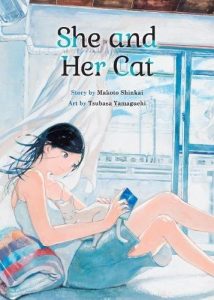
“In She and Her Cat, Shinkai does what he does best, using carefully curated imagery to set a somber tone that soothes readers into a quiet, meditative headspace.” (Vertical Comics)
By Preston Hatfield (Yamanashi–ken, 2009-10) for JQ magazine. Preston received a BA in English literature with an emphasis in creative writing and a minor in Japanese at the University of California, Davis. After spending an amazing year on JET in Yamanashi, he spent a year writing and interning with book publishing companies in New York. He currently lives in Cupertino, where he continues to cover local Japan–related stories for JQ.
This season, Vertical Comics releases two notable titles. The first is She and Her Cat, a story by acclaimed animator Makoto Shinkai, the mastermind behind 5 Centimeters Per Second and Your Name. The second is Mobile Suit Gundam Wing: Endless Waltz — Glory of the Losers, a multi-volume adventure starring everyone’s favorite fighting mecha. While very different in style, pacing, and subject matter, each title has a lot to offer its readers.
In She and Her Cat, Shinkai does what he does best, using carefully curated imagery to set a somber tone that soothes readers into a quiet, meditative headspace. From there he proceeds to unfold an understated vignette that explores adult depression. This is a timely story, our considering society’s gradual willingness to speak openly about depression and mental health more broadly.
Shinkai’s protagonist, Miyu, is a sympathetic introvert who has a hard time asking for or accepting help from others, and she is also her own antagonist, a fact that will likely resonate with readers who have battled depression. One unique feature about this story, which is also at times strained, is that it is told from the perspective of the protagonist’s cat, Chobi. While some readers may feel that Shinkai could have done more with this story, it is nonetheless well told and tactfully, intelligently handled.
By contrast, Glory of the Losers delivers action, explosions, and braggadocio. Based on creator Yoshiyuki Tomino’s classic 1970s giant robot series, the story follows a common trope: In a post-apocalyptic world, humans have broken off into different factions to colonize other planets. But when a central military agency begins annexing free colonies, a small resistance rises in the name of freedom to end their tyranny. This is an enjoyable underdog story that may have particular appeal to middle and high school students.
For more information, visit www.vertical-inc.com.
JQ Magazine: Nippon in New York — Bob James, Liberty City Anime Con, PLAY NYC
By JQ magazine editor Justin Tedaldi (CIR Kobe–shi, 2001-02). Justin has written about Japanese arts and entertainment for JETAA since 2005. For more of his articles, click here.
In the dog days of summer, it’s best to escape the heat in a place that’s cozy and cool. For those into Japan-related cultural events, this month offers a diverse selection of film premieres and live music—all in the comfort of indoor air conditioning.
This month’s highlights include:
Aug. 15-20, 8:00 p.m. and 10:30 p.m.
Bob James feat. special guests
Blue Note Jazz Club, 131 West Third Street
$20, $35
The career of multi-Grammy winner Bob James is long, varied and continues to evolve at every turn as he continues to captivate audiences throughout the world for more than 50 years, 58 albums, and innumerable awards. While James is recognized as one of the progenitors of smooth jazz, his music has also had a profound effect on the history of hip-hop, having been sampled frequently since the early days of the genre. A longtime star in Japan, he has recorded a piano duet album with Keiko Matsui, and worked with Seiko Matsuda as a guest vocalist on “Put Our Hearts Together,” written by James and his daughter Hilary in response to the Great East Japan Earthquake of 2011. Joining Bob and his special guests for the week’s sets are trumpeter Randy Brecker on Aug. 16.
Aug. 18-20, various times
New York Marriott Marquis, 1535 Broadway
$40-$60
The best three-day anime convention in New York City returns for its third year and features over 100 events and panels, three days of cosplay, game tournaments and anime screenings, concerts, balls and dances. This year’s special guests include Tyler Walker, Heather Walker, Chuck Huber, Aaron Roberts, Brittany Lauda, Matt Shipman, Ian Rubin, Dokudel, Michael A. Zekas, Marcus Stimac, and Reni Mimura!
Aug. 19-20, starts 10:00 a.m.
Terminal 5, 610 West 56th Street
$25
PLAY NYC is New York’s first and only dedicated games convention. The weekend will feature three floors of playable games for all consoles, PC, virtual reality and mobile devices from studios large and small and developers old and new. Games will include indie projects with some larger triple A titles. Get access to some of the biggest games coming later this year and discover many you’ve never even heard of. PLAY NYC celebrates every facet of gaming in a way that only the Big Apple can by uniting players, developers and industry pros at a games event like no other. Special guest speakers include multi-instrumentalist Zac Zinger of Japanese traditional/jazz fusion project KAI. Read More
JQ Magazine: Book Review — ‘The Seed of Hope in the Heart’
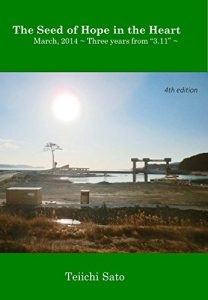
Although The Seed of Hope is a memoir of one man’s experiences during a challenging period in recent Japanese history, it is also a fascinating look into how the people of Tohoku struggled but fought to rebuild their lives. (Amazon Digital Services LLC)
By Rashaad Jorden (Yamagata–ken, 2008-10) for JQ magazine. A former head of the JETAA Philadelphia Sub–Chapter, Rashaad is a graduate of Leeds Beckett University with a master’s degree in responsible tourism management. For more on his life abroad and enthusiasm for taiko drumming, visit his blog at www.gettingpounded.wordpress.com.
There are certain moments we remember clearly as if they happened only yesterday, whether they are monumental historical events or natural disasters. But how would you tell stories centering on those moments?
Teiichi Sato has a go at it in The Seed of Hope in the Heart. In the memoir, Sato, an Iwate Prefecture seed shop owner, survives the 2011 Tohoku earthquake and tsunami but sees his beloved seed shop crumble. This plunges him into the task of rebuilding his life and livelihood amidst destruction while trying not to sink into depression and despair.
It all started with the disaster that struck on March 11, which didn’t actually come out of the blue. Sato explains that after a strong earthquake hit the Kesen area two days prior, a tsunami advisory was issued, which wasn’t really cause for a cause for concern as “weak” tsunami advisories were frequent around Rikuzentaka (where Sato lived).
But obviously, it should have been as for much of Tohoku, the world changed starting on 2:46 p.m. on March 11. Sato spends much of the early chapters detailing not only his perspective of the earthquake, but more dramatically his escape from the oncoming tsunami. While reading The Seed of Hope, you get the sense of being transported into a movie as it contains no shortage of drama as Rikuzentaka’s citizens make a desperate dash to find shelter—some of whom aren’t able to do so successfully.
JQ Magazine: Manga Review — ‘Kitaro and the Great Tanuki War’

“The Great Tanuki War stands apart from the other Kitaro volumes because in this adventure, the stakes are higher than anything you’ve ever seen.” (Drawn and Quarterly)
By Julio Perez Jr. (Kyoto-shi, 2011-13) for JQ magazine. A bibliophile, writer, translator, and graduate from Columbia University, Julio currently keeps the lights on by working at JTB USA while writing freelance in New York. Follow his enthusiasm for Japan, literature, and comic books on his blog and Twitter @brittlejules.
A haunted house built on an ancient burial ground? That’s minor league. How about an entire nation built above an army of human-hating yokai who command a catfish large enough to cause earthquakes?
Shigeru Mizuki’s Kitaro and The Great Tanuki War is a manga volume that tells an epic tale pitting the titular character, Kitaro, against an army of tanuki and their powerful yokai allies. There are also a few bonus stories with Kitaro’s usual one-shot adventures. You may already be familiar with Mizuki’s famous character, but if you are not, you can brush up on his origin story featured in the first volume, The Birth of Kitaro, which JQ reviewed last year here.
This marks the third volume in the English collection of Kitaro stories published by the fine folks at Drawn and Quarterly. One of our very own JET alums, Zack Davisson (Nara-ken, 2001-04; Osaka-shi, 2004-06), has been doing his part to put Shigeru Mizuki’s timeless work on the map in the English-speaking world. He has served as translator for these Kitaro stories and also for Mizuki’s colossal four-volume manga history of the Showa period. Zack is a yokai expert in his own right and you can find out more about his career and JET experience in our vintage JQ interview with him.
As many consumers of Japanese media may already be aware, yokai are strange creatures or phenomena that originate in Japan and have become widely popular globally. Kitaro is a unique yokai who solves mysteries and fights for humans. The conflict between humans and yokai is often an issue of tension for him as he straddles both sides, but this conflict takes center stage in The Great Tanuki War, when an army of tanuki escape from their underground dwelling beneath the island of Shikoku (shout-out to our Shikoku JET alums!), to wage a war on the human residents of Japan.

